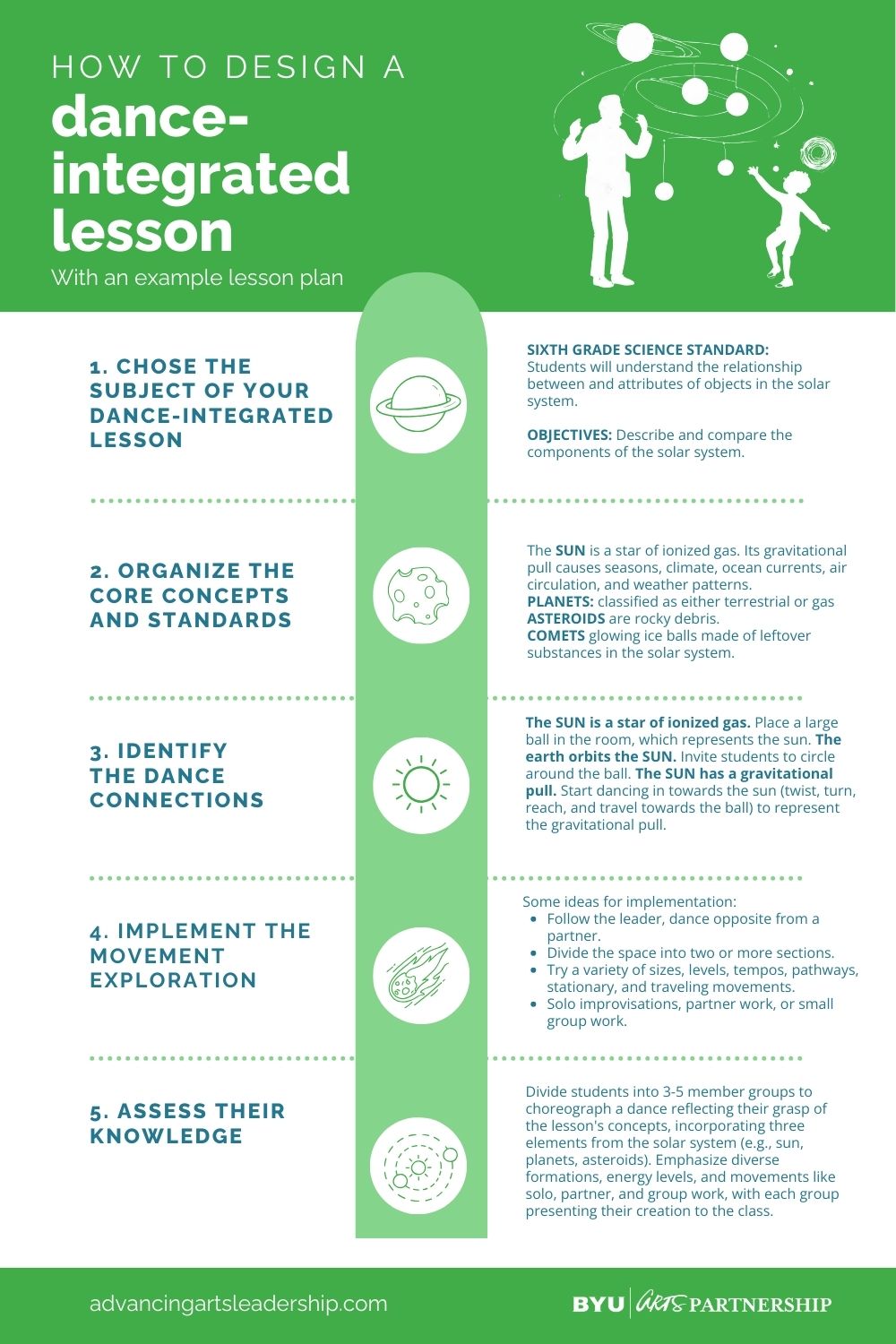How to Integrate Dance with Core Subjects

This article demonstrates how to create an integrated dance lesson plan by outlining a lesson plan for teaching sixth-grade science standards related to the solar system. It provides strategies for introducing core concepts through movement, finding the connections between curricular content and dance activities, and offers assessment strategies involving group dances, dance stations, and creative activities.
1. Chose the Subject of Your Dance-Integrated Lesson
For more integration ideas, refer to the state core standards and objectives or click here to visit the danceable ideas blog!
SIXTH GRADE SCIENCE STANDARD:
Students will understand the relationship between and attributes of objects in the solar system.
OBJECTIVES: Describe and compare the components of the solar system.
- Identify the planets in the solar system by name and relative location from the sun.
- Using references, compare the physical properties of the planets (e.g., size, solid, or gaseous).
- Describe the characteristics of comets, asteroids, and meteors.
2. Organize the Core Concepts and Standards
- The SUN is a star of ionized gas. Its gravitational pull causes seasons, climate, ocean currents, air circulation, and weather patterns. The sun supports all life by giving off heat, light, and energy.
- PLANETS are classified as either terrestrial (Mercury, Venus, Earth, and Mars) or gas (Jupiter, Saturn, Uranus, and Neptune).
- ASTEROIDS are rocky debris.
- COMETS are dirty, glowing ice balls made of leftover substances in the solar system. Found far beyond Pluto, comets contain a nucleus and have a tail that increases the closer it gets to the sun.
- METEORS are small rocky or metallic bodies traveling through space. They burn up as they pass through the earth's atmosphere. Nicknamed "shooting stars", meteors are not stars.
- STARS are huge spheres of glowing gas, often found in clusters.
3. Identify the Dance Connections
Thoughtfully create a teacher script by writing out the verbalization to be used when guiding students through movement explorations. Determine which dance connections will complement the core concepts being taught. Teachers can connect the concepts with dance elements, other moves, action words, improvisation or choreography.
Following is an example of how teachers might connect core ideas about the solar system with danceable action:
- The SUN is a star of ionized gas. Place a large ball in the center of the room, which represents the sun.
- The earth orbits the SUN. Invite students to circle around the ball.
- The SUN has a gravitational pull. Start dancing in towards the sun (twist, turn, reach, and travel towards the ball) to represent the gravitational pull.
- The SUN supports life by giving off heat, light, and energy. Dance (twist, turn, and travel) away from the sun, reaching outward to represent giving off heat, light, and energy. Repeat this movement sequence (moving toward and away from the sun) several times. Continue brainstorming movement ideas that complement each concept being taught.
4. Implement the Movement Exploration
How can teachers help students experience and identify the content objectives through movement? How will students be able to further explore and investigate those ideas through significant movement challenges? What preparatory learning experiences do students need to create and perform dances that demonstrate their knowledge at the end of class?
Consider the following implementation ideas:
- Solo improvisations, partner work, or small group work.
- Circles, lines, scattered, or other formations.
- Follow the leader, dance opposite from a partner.
- Class divisions (e.g., light-eyed students freeze in a shape while dark-eyed students dance around them).
- Small group, partner, or whole-class choreography.
- Divide the space into two or more sections.
- Try a variety of sizes, levels, tempos, pathways, stationary, and traveling movements.
- Remember to avoid pantomime.
5. Assess Their Knowledge
Assess students' knowledge by providing an experience that allows them to apply what they learned. These assessments can be used independently or combined for greater integration.
Divide the class into groups of 3-5 students. Ask each group to create a dance that applies their knowledge of the lesson. Direct students to begin and end their dance in a shape. The dance must also contain three of the lesson concepts (sun, planets, asteroids, comets, meteors, stars). The students must find ways to dance those concepts as a small group, use interesting formations and a variety of energy qualities, include solo, partner and whole group work, and incorporate various tempos and rhythms. Each small group will perform for the rest of the class.
After exploring each part of the solar system, create dance stations for each concept (i.e., the sun station, planets station, asteroids station, meteors station, and/or stars station). Assign students to different stations, allot a time restriction for their movement exploration at that station, and rotate stations until each student has danced each concept of the solar system.
Call out the different concepts they just danced (e.g., comets, stars, sun, planets, etc.). Students need to dance the concept as soon as the teacher verbalizes the concept. Students will be dancing the same concept multiple times.
Invite students to create a song about the solar system. Or, create a visual art piece as a class that includes all the concepts of the solar system. Direct a discussion about what students learned concerning the solar system.







